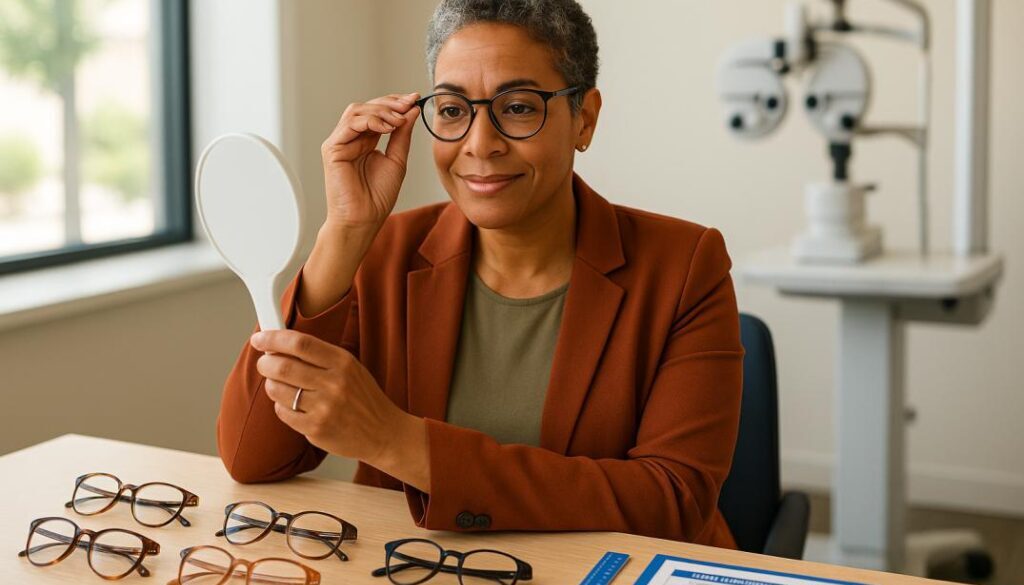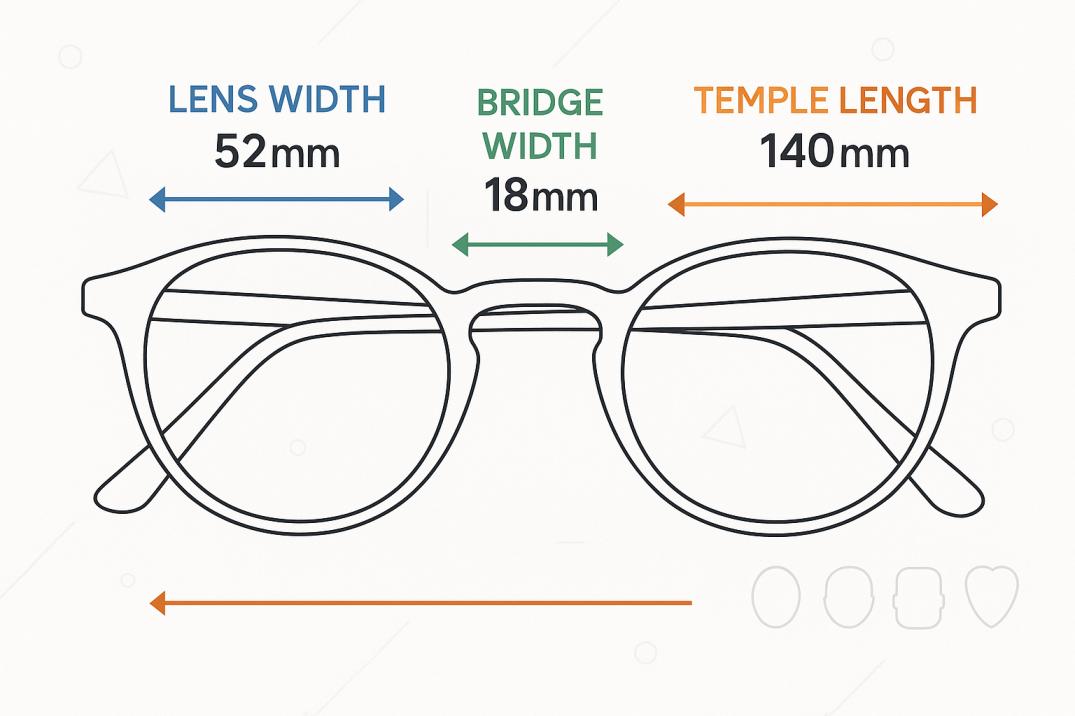Frame Fit Guide: Find Perfect Eyeglasses for Your Face Shape
Bottom Line Up Front: This comprehensive frame fit guide shows you how to choose eyeglass frames that truly fit by understanding three key measurements (lens width, bridge size, and temple length), identifying your face shape, and ensuring proper alignment with your features. Well-fitting frames should sit comfortably without sliding, pinching, or causing pressure points while keeping your eyes centered in the lenses.
Getting new glasses should be exciting, not frustrating. Yet many people struggle with frames that slide down their nose, pinch their temples, or simply don’t look right. The difference between glasses you love and glasses you tolerate comes down to proper fit—and knowing how to choose eyeglass frames that work for your unique features is more achievable than you might think.
At Poudre Valley Eyecare, we’ve spent over 25 years helping Fort Collins families find frames that truly work for their faces and lifestyles. This frame fit guide provides the expertise you need to make confident choices, whether you’re shopping online or in person, ensuring your eyewear enhances both your vision and your comfort.
Understanding the Anatomy of Eyeglass Fit
Why Proper Frame Fit Matters for Your Vision and Eye Health
Poorly fitting frames don’t just feel uncomfortable—they can strain your eyes and affect your vision quality. When frames are too loose, they move around and force your eyes to work harder to look through the lenses properly. When they’re too tight, they create pressure points that can lead to headaches and discourage consistent wear.
Research from the National Center for Biotechnology Information shows that proper frame fit directly impacts both visual comfort and long-term eye health, making this knowledge essential for anyone choosing new eyewear.
The Three Critical Measurements Every Frame Needs
Every pair of glasses displays three numbers on the inside of the temple arm—usually something like “52-18-140.” These aren’t random numbers; they’re the key to finding your perfect fit and essential for anyone learning how to choose eyeglass frames:
Lens Width (Eye Size): The first number measures the horizontal width of each lens at its widest point, typically ranging from 44-62mm. Your eyes should be centered within the lenses for optimal vision. Choose based on your face size:
- Small faces: 47-50mm
- Medium faces: 51-54mm
- Large faces: 55mm and above
Bridge Width: The middle number indicates the distance between your lenses—essentially, where the glasses rest on your nose. This measurement ranges from 14-24mm and is crucial for preventing sliding or pinching.
Temple Length: The final number measures each temple arm from the hinge to the tip. Standard lengths include 135mm, 140mm, 145mm, and 150mm, with the temples needing to extend comfortably behind your ears without protruding too far.
How to Choose Eyeglass Frames: Step-by-Step Measuring Guide
Step-by-Step Frame Fit Guide
Getting accurate measurements at home is simpler than you might expect. This frame fit guide walks you through the process using basic tools you likely already have.
Measuring Your Current Glasses
If you have glasses that fit well, start there. Look for the three-number sequence printed on the inside temple arm, usually separated by dashes or small icons. These become your baseline measurements when shopping for new frames.
Taking Your Facial Measurements
Frame Width: Stand in front of a mirror and measure the distance between your left and right temples. This total width should closely match your glasses’ combined lens and bridge measurements (within 2-4mm).
Bridge Measurement: Look at your nose bridge in the mirror and gauge its width. If your bridge sits at or below your pupil level, you likely need a smaller bridge size (16-18mm). If it’s above your pupils or particularly wide, opt for 19-21mm.
Temple Length Assessment: Measure from where glasses would sit on your nose to just behind your ear. Most people fall into the 135-150mm range, with longer temples needed for larger heads.
Face Shape Analysis: How to Choose Eyeglass Frames That Flatter
The Foundation of How to Choose Eyeglass Frames
Understanding your face shape provides a helpful starting point when you choose eyeglass frames, though personal style and comfort should never be overlooked. Think of face shape as a useful tiebreaker when you’re deciding between frames you like.
Round Faces: Adding Definition and Structure
Round faces feature soft curves and are roughly the same width from jaw to brow. The key is selecting frames that add angles and definition to complement your natural curves.
Best Frame Choices:
- Rectangular and square frames that add sharp lines
- Geometric styles with bold, angular details
- Cat-eye frames that lift and elongate
- Browline glasses that emphasize the upper face
Avoid: Small, round frames that emphasize facial curves
Square Faces: Softening Strong Angular Features
Square faces have strong jawlines and broad foreheads with relatively straight lines. The goal is to choose frames that soften these angles while maintaining balance.
Best Frame Choices:
- Round and oval frames that create gentle curves
- Frames that sit higher on the nose to add length
- Cat-eye styles for a bold statement
- Curved designs that balance cheekbones
Avoid: Heavy, boxy frames that emphasize angular features
Oval Faces: The Versatile Canvas
Oval faces are naturally balanced with proportionate sides and gently rounded foreheads and chins. This shape works well with almost any frame style.
Best Frame Choices:
- Wide or oversized frames for character
- Square, round, or rectangular styles
- Bold geometric designs
- Cat-eye frames for drama
Frame Width Tip: Choose frames slightly wider than your face for the most flattering look
Heart-Shaped Faces: Balancing Forehead and Chin
Heart faces feature broad foreheads with narrow chins, creating a classic triangle shape. The strategy is adding width to the lower face while minimizing forehead emphasis.
Best Frame Choices:
- Bottom-heavy frames like aviators
- Round frames that draw attention downward
- Frames with low-set temples
- Square and rectangular styles for balance
Avoid: Top-heavy frames that emphasize forehead width
Diamond Faces: Complementing Unique Proportions
Diamond faces are narrow at both the top and bottom with wider cheekbones. The ideal frames maintain evenness throughout their shape without dramatic details.
Best Frame Choices:
- Browline glasses with balanced proportions
- Cat-eye frames that follow natural lines
- Round and oval styles that soften angles
- Semi-rimless designs for subtlety
The Science of Proper Glasses Fit
How Frame Fit Affects Your Vision and Comfort
According to 2025 research in parametric eyewear design, fit and comfort are largely dependent on personal perceptions, but certain measurable factors consistently improve the wearing experience. Studies show that proper frame fit directly impacts vision quality and reduces eye strain—when frames sit properly, they should feel almost invisible.
Key Fit Indicators to Check
Bridge Comfort: Your glasses should rest securely on your nose bridge without pinching or leaving marks. You should be able to move your head side to side without the frames sliding down.
Temple Pressure: The temple arms should sit comfortably on your ears without notable pressure. If they dig in behind your ears, the frames are too tight or need professional adjustment.
Eye Positioning: Your eyes should be centered within the lenses both horizontally and vertically. If you’re looking through the outer edges of your lenses, the frames are too wide.
Cheek Contact: Your frames shouldn’t touch your cheeks when you smile or talk. If they do, you may need frames with adjustable nose pads or a different bridge height.
Common Frame Fit Problems and Professional Solutions
How Do I Stop My Glasses From Slipping?
This is perhaps the most common complaint, and it usually stems from incorrect bridge width or overall frame size. Here’s how to fix sliding glasses:
Quick Fixes:
- For glasses with adjustable nose pads, gently move them closer together using needle-nose pliers to narrow the bridge fit
- Add adhesive nose pads to frames without adjustable options
- Consider frames with a smaller bridge width (decrease by 1-2mm)
Professional Solutions:
- Bridge adjustment for better nose contact
- Temple angle modification for improved balance
- Frame size consultation for better proportions
Why Do My Glasses Hurt My Nose and Ears?
Frames that are too tight can cause headaches, nose pain, and skin irritation. Quality frames made from lightweight materials like titanium or acetate help reduce pressure on your nose and ears.
Immediate Relief:
- Gently widen nose pads if adjustable
- Use temple cushions for ear comfort
- Apply moleskin to pressure points temporarily
Long-term Solutions:
- Choose frames with larger bridge measurements
- Select lightweight frame materials
- Consider frames designed for your specific face width
What If My Glasses Sit Too High or Too Low?
Your frames’ top line should align with your eyebrow shape, and your eyebrows shouldn’t be visible through the lenses. The bottom should rest above your cheeks for optimal balance.
Adjustments Needed:
- Bridge height modification
- Nose pad repositioning
- Different frame style with appropriate lens height
Lifestyle Considerations for Frame Selection
Matching Frames to Your Daily Activities
Your lifestyle should heavily influence frame choice. Athletes and those in labor-intensive jobs need durable frames that stay put during activities, while business professionals might prioritize stylish frames that project confidence.
Active Lifestyles and Sports
- Choose wraparound styles for better coverage
- Prioritize lightweight, flexible materials
- Ensure a secure temple fit to prevent slipping
- Consider impact-resistant frame materials
Professional Environments
- Select classic shapes that project competence
- Choose neutral colors that complement work attire
- Ensure frames don’t overwhelm facial features
- Consider anti-reflective coatings to reduce glare during presentations
Digital Device Users
Modern life involves significant screen time, making frame comfort during extended wear crucial.
- Lightweight materials reduce fatigue
- A proper bridge fit prevents sliding during computer work
- Blue light filtering lenses work best in properly fitted frames
Advanced Fit Considerations
Special Bridge Fits and Adjustments
Some people benefit from specialized Low Bridge Fit glasses, designed for those with low nose bridges, wide faces, or high cheekbones. These frames feature:
- Lower-sitting bridges for better contact
- Curved bridge designs that follow facial contours
- Wider nose pad spacing for comfort
- Different angle geometry for improved fit
Progressive and Multifocal Lens Requirements
Lens height becomes especially important for progressive and bifocal wearers, who need at least 30mm of vertical lens space to accommodate different vision zones. For high prescriptions (+/-6.00 and above), it’s best to stick with lens widths of 50mm or less to minimize lens thickness and weight, which can cause frames to slide down the nose.
Frame selection must balance:
- Adequate lens height for vision correction zones
- Proper eye positioning within the progressive corridor
- Comfortable fit that maintains consistent lens-to-eye distance
Children’s Frame Fit Considerations
Growing children present unique fitting challenges:
- More frequent adjustments are needed as facial features change
- Durable materials to withstand active play
- Secure fit that doesn’t restrict movement
- Style considerations that encourage consistent wear
Professional vs. DIY Frame Fitting
When to Seek Professional Help
While minor adjustments can be made at home, trained eyewear professionals provide proper measurements and guidance to ensure frames are the right size and fit from the start.
Professional Benefits:
- Precise pupillary distance measurements and frame size recommendations
- Expert assessment of facial features and proportions
- Specialized tools for accurate adjustments
- Experience with various frame materials and styles
DIY Limitations:
- Risk of damaging frames during adjustment attempts
- Difficulty achieving precise measurements
- Limited ability to modify frame structure
- Potential safety issues with improper adjustments
Technology and Future of Frame Fitting
Advanced AR and Virtual Try-On Technology
Digital retailers now offer sophisticated AR applications that allow realistic visualization of frames on your face, while some retailers offer home try-on programs that ship multiple frame options for physical testing. According to 2025 industry data, the e-commerce segment of the eyewear industry witnessed a year-over-year growth of 25% in recent years, driven by the convenience and variety offered by online retailers, though traditional brick-and-mortar stores continue to dominate overall revenue at approximately 76-80% of the market.
Emerging Innovations in 2025
- 3D printing technology that creates custom frames based on facial scans for a perfect fit
- Biometric sensors embedded in frames for health monitoring and blink pattern analysis
- Smart materials that adjust to temperature and activity levels
- Enhanced photochromic lenses with transition times under 30 seconds
- Advanced blue light filtering that selectively blocks harmful wavelengths without yellow tinting
Maintaining Your Perfect Fit
Regular Adjustment and Care
Even perfectly fitted frames need occasional adjustments:
- Regular eyeglass wear can change frame shape over time, especially for growing children who need frequent adjustments
- Seasonal changes in facial swelling may affect the fit
- Frame materials can loosen or tighten with temperature changes
Signs Your Frames Need Professional Attention
- Persistent sliding despite home adjustments
- Uneven sitting that makes frames appear crooked
- New pressure points or discomfort areas
- Changes in vision clarity that might indicate lens misalignment
Making the Final Decision: Style Meets Function
Balancing Personal Preference with Proper Fit
Remember that face shape guidelines aren’t rigid rules—personal style and confidence matter most. The best frames are those that make you feel comfortable and confident while providing clear, comfortable vision.
Questions to Ask Before Purchasing Frames
- Do these frames feel comfortable after wearing for several minutes?
- Can I move my head normally without the frames shifting?
- Do my eyes appear centered in the lenses?
- Does the style reflect my personality and lifestyle needs?
- Are the measurements within an appropriate range for my facial features?
Your Next Steps to Perfect Frame Fit
Finding frames that fit your face transforms your entire eyewear experience. When your glasses fit properly, you’ll forget you’re wearing them—which is exactly how it should be.
Action Plan for Your Frame Shopping:
- Measure your current glasses if you have a pair that fits well
- Determine your face shape using this frame fit guide
- Consider your lifestyle needs and daily activities
- Try on multiple styles within your preferred measurement ranges
- Test the fit by moving your head and checking comfort points
- Seek professional fitting for final adjustments and optimization
This frame fit guide gives you the foundation to choose eyeglass frames with confidence, but every face is unique. Professional consultation ensures your specific needs are met with precision and care.
Resources and Citations
This comprehensive frame fit guide is based on current industry research, optical standards, and peer-reviewed studies. Here are key sources that informed this article:
1. Eyeglass Frame Measurements and Standards
Warby Parker Learning Center – Glasses Measurements Guide
Updated March 20, 2025
https://www.warbyparker.com/learnes-measurements
This authoritative source provides current industry standards for frame measurements, including the confirmed ranges for lens width (44-62mm), bridge width (14-24mm), and temple length specifications. Referenced for technical measurement guidelines and proper fitting criteria.
2. Parametric Design and Fit Research
PMC – Parametric Design for Custom-Fit Eyewear Frames
National Center for Biotechnology Information
https://pmc.ncbi.nlm.nih.gov/articles/PMC10559553/
This peer-reviewed research study examines the relationship between frame fit, comfort, and personal perception in eyewear design. Referenced for scientific insights on how proper fit affects vision quality and the challenges of objective fit evaluation.
3. 2025 Eyewear Industry Market Data
Fortune Business Insights – Global Eyewear Market Report
Growth Report 2025-2032
https://www.fortunebusinessinsights.com/industry-reports/eyewear-market-101749
Current market analysis providing 2025 statistics on eyewear usage (66% of American adults use vision correction), market growth rates (6-8% CAGR), and technology trends, including photochromic lens advancements and biometric sensor integration, are referenced throughout the article.
Professional Frame Fitting in Fort Collins
At Poudre Valley Eyecare, our 25+ years of experience in Fort Collins means we understand how proper frame fit impacts your daily life. We take the time to ensure your glasses not only correct your vision but also feel comfortable and look great, too.
Our comprehensive approach includes precise measurements, lifestyle consultations, and ongoing adjustments to keep your frames fitting perfectly as your needs change. Because when your glasses fit right, everything else falls into place.
Current 2025 eyewear market data shows that approximately 66% of American adults use some form of vision correction, with 64% using prescription eyewear specifically. The global eyewear market, valued at over $200 billion in 2024, continues to grow at a compound annual growth rate of 6-8%, driven by increasing screen time, aging populations, and growing awareness of eye health.
Ready to find frames that fit? Contact Poudre Valley Eyecare to schedule a comprehensive fitting consultation. We’ll help you discover eyewear that enhances both your vision and your confidence—because that’s what quality eye care looks like.
Additional technical guidance and fitting recommendations are based on 25+ years of clinical experience at Poudre Valley Eyecar, serving the Fort Collins community.
FAQs
-
Contrast your natural face shape: oval faces need rectangular frames, square faces suit round frames, round faces need angular shapes, and heart-shaped faces look best with oval or square styles.
Please note: None of the above should be considered medical advice. If you’re having any concerns about your vision, please reach out to us immediately or see your primary care provider.





